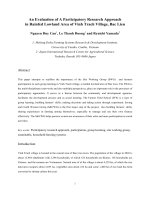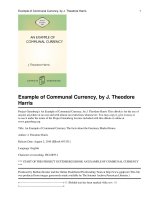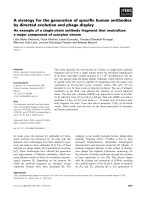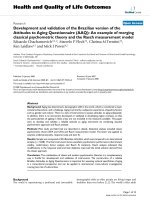Debating same sex marriage an example of a cultural revolution
Bạn đang xem bản rút gọn của tài liệu. Xem và tải ngay bản đầy đủ của tài liệu tại đây (16.92 MB, 230 trang )
Debating Same Sex Marriage:
An Example of a Cultural
Revolution
Debating Same Sex Marriage: An
Example of a Cultural Revolution
Margaret F. Bello
Publishing
www.societypublishing.com
Debating Same Sex Marriage: An Example of a Cultural Revolution
Margaret F. Bello
Society Publishing
224 Shoreacres Road
Burlington, ON L7L 2H2
Canada
www.societypublishing.com
Email:
e-book Edition 2022
ISBN: 978-1-77469-251-6 (e-book)
This book contains information obtained from highly regarded resources. Reprinted material
sources are indicated and copyright remains with the original owners. Copyright for images and
other graphics remains with the original owners as indicated. A Wide variety of references are
listed. Reasonable efforts have been made to publish reliable data. Authors or Editors or Publishers are not responsible for the accuracy of the information in the published chapters or consequences of their use. The publisher assumes no responsibility for any damage or grievance to the
persons or property arising out of the use of any materials, instructions, methods or thoughts in
the book. The authors or editors and the publisher have attempted to trace the copyright holders
of all material reproduced in this publication and apologize to copyright holders if permission has
not been obtained. If any copyright holder has not been acknowledged, please write to us so we
may rectify.
Notice: Registered trademark of products or corporate names are used only for explanation and
identification without intent of infringement.
© 2022 Society Publishing
ISBN: 978-1-77469-064-2 (Hardcover)
Society Publishing publishes wide variety of books and eBooks. For more information about
Society Publishing and its products, visit our website at www.societypublishing.com.
ABOUT THE AUTHOR
Margaret Bello-Digamon has Doctorate in Development Management major
in Educational Administration from the Ateneo de Zamboanga University
where she graduated in 2019. At present she is finishing her Certificate in
Teaching English as a Secondary Language at the University of Saskatchewan,
Canada. She also finished her Master’s degree in Engineering Education major
in ICT at the Western Mindanao State University and graduated with a Bachelor
of Science in Management Information Systems in 2003 from the Ateneo de
Zamboanga University. She’s had 7 years’ experience as a College Dean where
she has immersed herself in the education and an administrative setting that
include dealing and counseling clients and have successfully developed and
aided in writing programs with advocacies promoting the welfare of women
and children through technology. She is married with two children and currently
resides in Saskatchewan Canada.
TABLE OF CONTENTS
List of Figures.................................................................................................xi
List of Abbreviations.....................................................................................xiii
Preface..........................................................................................................xv
Chapter 1
Introduction to the Institution of Marriage................................................ 1
1.1. Initial Conceptualizations of Marriage................................................. 2
1.2. The Implications of Marriage................................................................ 6
1.3. Typologies of Marriage....................................................................... 12
1.4. Selecting a Marriage Partner.............................................................. 18
1.5. The Economics of Marriage................................................................ 22
Chapter 1 Summary.................................................................................. 27
Chapter 2
The Legal Framework of Marriage............................................................ 29
2.1. Standard Requirements for an Effective Marriage............................... 30
2.2. Race, Gender in Marriage.................................................................. 35
2.3. Civil Unions and Power Relations in Marriage................................... 41
2.4. Regulation of Sexual Relations in Marriage........................................ 47
2.5. Legitimacy of Children Born in and Outside Marriage....................... 53
Chapter 2 Summary.................................................................................. 59
Chapter 3
Religiosity of Marriage............................................................................. 61
3.1. Christian Conceptualization of Marriage............................................ 62
3.2. Islamic Conceptualization of Marriage............................................... 67
3.3. Judaism and Marriage Law................................................................. 72
3.4. Denominational Diversity in Marriage............................................... 77
3.5. Theological Views on Marriage.......................................................... 82
Chapter 3 Summary.................................................................................. 87
Chapter 4
Norms and Customs Concerning Marriage............................................... 89
4.1. Christian, Hindu, and Jewish Influences............................................. 90
4.2. Islamic, Chinese, and Humanist Perspectives..................................... 93
4.3. Typologies of Weddings..................................................................... 99
4.4. Participation in Weddings and the Marriage Industry....................... 106
4.5. Issues of Health and Wellbeing in Marriage..................................... 110
Chapter 4 Summary................................................................................ 117
Chapter 5
Religious Objections to Non-Heterosexual Couples............................... 119
5.1. LGBT Perspectives on Religion........................................................ 120
5.2. Buddhist Perspectives on LGBT Communities.................................. 127
5.3. Christian Perspectives on LGBT Communities.................................. 130
5.4. Perspectives of Unitarian Universalists and Unitarians on
LGBT Communities....................................................................... 137
5.5. Islamic Perspectives on LGBT Communities..................................... 139
Chapter 5 Summary................................................................................ 141
Chapter 6
Case Study of Institutionalized Homophobia in Africa........................... 143
6.1. LGBT Rights in Africa...................................................................... 144
6.2. History of LGBT Communities in Africa........................................... 148
6.3. Case Study of Uganda and Kenya.................................................... 151
6.4. Schism in the Anglican Union Over Same-Sex Marriage.................. 157
6.5. Case Study of LGBT Rights in South Africa....................................... 163
Chapter 6 Summary................................................................................ 165
Chapter 7
The Notion of Same-Sex Marriage.......................................................... 167
7.1. The Status of Same-Sex Couples Today............................................. 168
7.2. Historical Progression Towards Same-Sex Marriage.......................... 171
7.3. Global Treatment of Same-Sex Marriage.......................................... 173
7.4. Case Study of the Same-Sex Marriage in the United Kingdom.......... 177
7.5. Case Study of the Same-Sex Marriage in the USA............................ 179
Chapter 7 Summary................................................................................ 182
Chapter 8
The Future of Same-Sex Relationships.................................................... 183
8.1. National Debates About Same-Sex Relationships............................. 184
8.2. Alternatives to Same-Sex Marriage................................................... 187
viii
8.3. Managing Same-Sex Divorces.......................................................... 189
8.4. Continuing Discrimination Against Same-Sex Couples..................... 191
8.5. Towards Universal Marriage Equality............................................... 193
Chapter 8 Summary................................................................................ 195
Chapter 9
Concluding Remarks.............................................................................. 197
Bibliography........................................................................................... 199
Index...................................................................................................... 207
ix
LIST OF FIGURES
Figure 1.1. Traditional religious conceptualization of marriage
Figure 1.2. Reasons as to why people get married
Figure 1.3. Basic typology of marriages
Figure 1.4. Example of a compatibility matrix for a dating agency
Figure 1.5. The economics of marriage and divorce
Figure 2.1. Standard requirements for an effective marriage in North Carolina
Figure 2.2. Race and intermarriage
Figure 2.3. The effects of power play in a marriage or intimate relationships
Figure 2.4. Control of sexual relationships in a marriage
Figure 2.5. Race and children born out of wedlock in the USA
Figure 3.1. The Christian conceptualization of marriage
Figure 3.2. Islamic conceptualization of marriage
Figure 3.3. Marriage in Israel
Figure 3.4. Changing religious affiliations from 1911 to 2016
Figure 3.5. Theological views on marriage
Figure 4.1. Religiosity and household size
Figure 4.2. Views on women in Confucianism and Daoism
Figure 4.3. Rising uptake of same-sex weddings in Sweden
Figure 4.4. High expenditure in US wedding industry
Figure 4.5. Negative effects of marital discord on health
Figure 5.1. Perspectives of white evangelicals on homosexuality and religion
Figure 5.2. Buddhist perspectives on LGBT communities
Figure 5.3. Contrasting African and European perspectives on homosexuality
Figure 5.4. Perspectives of Unitarian Universalists and Unitarians on LGBT
communities
Figure 5.5. National diversities in the level of acceptance of homosexuality
Figure 6.1. LGBT rights in Africa
Figure 6.2. Penalties against LGBT people in Africa
Figure 6.3. Case study of the public outing of LGBT people in Kenyan media
Figure 6.4. Africans in the Anglican community
Figure 6.5. South Africa’s first gay Imam
Figure 7.1. State of same-sex marriage across the globe
Figure 7.2. Historical progress of same-sex marriage in the USA
Figure 7.3. Sexual orientation laws across the globe
Figure 7.4. Timeline of same-sex relationships and marriage in the UK
Figure 7.5. The role of the supreme court in gay marriage bans in the USA
Figure 8.1. Partisanship and changes in public opinion on same-sex marriages in the
USA
Figure 8.2. Differentiated same-sex relationships in the USA
Figure 8.3. Rate of same-sex splits in the USA by 2011
Figure 8.4. Voices of children from rainbow families
Figure 8.5. Policy priorities for LGBT couples
xii
LIST OF ABBREVIATIONS
AIDS
Acquired Immunodeficiency Syndrome
GOP
Grand Old Party
HIV
Human Immunodeficiency Viruses
LGBT
Lesbian, Gay, Bisexual, and Transgender
PREFACE
There was a time when merely expressing same-sex attractions could get you hanged
in many countries across the globe. Now, we are talking about same-sex marriage.
If someone living on earth in the 1930s was brought back to life today, they would
be amazed at the changes in attitudes towards sexual minorities. Homosexuality used
to be considered one of the most heinous crimes, even in the enlightened countries
of Europe. The harshest punishments were prescribed for known homosexuals. In the
literary world, we have the example of Oscar Wilde, who was carted off to prison with
hard labor for engaging in “sodomy.”
The so-called “sodomites” were seen as an embarrassment, and this “love that dare
not speak its name” was punished wherever and whenever it was identified. Populist
homophobia took hold of many nations, and the moralists were arguing that to support
homosexuals in any way was to allow for the destruction of society as we know it.
Then there was the AIDS (acquired immunodeficiency syndrome) scourge of the 1980s
when medical practitioners were talking about a deadly “Gay Cancer,” and the US
Administration (headed by the perpetually popular Ronald Reagan) was accused of not
responding fast enough to the plight of largely gay men who were dying at alarming
rates. True help only came from the state when white heterosexual people started
developing AIDS.
In the meantime, the gay community had to contend with discrimination in virtually all
spheres of life. Members were denied job opportunities and even accommodation for
no other reason other than their assumed or confirmed sexuality. Casually homophobic
stereotypes and insults polluted our television screens and popular media without any
complaint. Indeed, any portrayal of gay people was controversial unless they were
laughed at or getting their assumed “comeuppance” for being sexually immoral. All
things considered, it seems that sexual minorities in general and gay people were
destined to remain on the margins of society. Discrimination against them was readily
accepted as a societal norm.
Those who were overly optimistic at the time considered the possibility of acceptance
as citizens who could be so without threats of state-sponsored and vigilante violence
or extermination as the Nazis had once proposed. The evolution from that modest
ambition to the acceptance of same-sex marriage is nothing short of remarkable. It all
started in a handful of progressive nations and then started moving forward with a speed
that campaigners could hardly have anticipated 40 years ago. Young people were at the
heart of this evolution in terms of letting the older generations know that bigotry and
intolerance of sexual minorities were no longer going to be an acceptable norm for the
Millennials and beyond.
This book charts the debates and evolution of same-sex marriage as a key point and
process in the acceptance of sexual minorities. The book also raises questions about
as-yet-unanswered questions about the future of LGBT people and marriage in general.
For example, it is not yet clear that religious authorities are willing to fully accept
LGBT people. Meanwhile, there is a contingent of socially conservative nations that
are going through something of a backlash against LGBT rights. In doing so, this book
re-evaluates the meaning and implications of same-sex marriage.
xvi
CHAPTER 1
INTRODUCTION TO THE
INSTITUTION OF MARRIAGE
CONTENTS
1.1. Initial Conceptualizations of Marriage................................................. 2
1.2. The Implications of Marriage................................................................ 6
1.3. Typologies of Marriage....................................................................... 12
1.4. Selecting a Marriage Partner.............................................................. 18
1.5. The Economics of Marriage................................................................ 22
Chapter 1 Summary.................................................................................. 27
2
Debating Same Sex Marriage: An Example of a Cultural Revolution
The first chapter in this book will explore the institution of marriage as a
precursor to defining who and what exactly is included or excluded from
that institution. The first section of this initial chapter will highlight a range
of conceptualizations of marriage. In the second section, we will highlight
some implications of the state of being married. The third section summarizes
some typologies of marriage. In the 4th section, we will explore the process
of selecting potential and actual marriage partners. The last section in this
chapter will summarize the economic considerations in marriage. By the
end of this initial chapter, the reader should have a good understanding
of the heterosexist or alternatively homophobic foundations of traditional
marriage, which have in many instances rendered it an unfriendly place for
non-heterosexual and non-cisgender people.
1.1. INITIAL CONCEPTUALIZATIONS OF
MARRIAGE
The most traditional definition of marriage implies wedlock in which people
come together in a legal and binding union that is widely recognized from
a social perspective (Alderson, 2004; Appleton, 2005; Auchmuty, 2004;
Badgett, 2009; Ball, 2014, 2015; Barclay and Fisher, 2003). Marriage is
cultural in as much as it is social, and the understanding of marriage is
therefore constructed alongside the norms and values of any given society.
For example, whereas polygamy is widely recognized and even encouraged
in Nigeria; it is an aberration in Norway and, in fact, can lead to serious
legal. Figure 1.1 demonstrates the traditional Catholic conceptualization of
marriage.
Marriage creates rights and obligations for both parties as well as the
community at large (Chambers, 1997; Chamie and Mirkin, 2011; Coolidge,
1997; Corvino and Gallagher, 2012; Cox, Navarro-Rivera, and Jones,
2014). For example, there was a time when married people were given
exclusive rights to certain jobs, positions, and even pensions for no other
reason than the fact that they were married. It is important to note that from
a sociological point of view, the award of certain rights and responsibilities
is both exclusive and inclusive. For example, whereas the widow’s pension
will give protection to women who have lost their husbands; it excludes
coverage to those that are unmarried. In his modality of inclusive and
exclusive rights, gendered relations are reinforced.
Introduction to the Institution of Marriage
3
Figure 1.1: Traditional religious conceptualization of marriage.
Source: Catholic-Link via Twitter.
Women are almost always on the receiving end of the worst bargain of
the lot. There is an implicit understanding that the female member of a couple
of other marriage arrangements is merely an attachment for the purpose of
improving the wellbeing of their male counterpart. Such obligations have
proved so onerous for some women that they are beginning to question
their very role within the institution and whether it makes sense for them to
continue cultivating and meeting the obligations placed on them.
One of the reasons why marriage has been questioned as a societal
institution is the fact that it is not entirely inclusive (Hull, 2003; Hull and
Hull, 2006; Hunter, 2012; Josephson, 2005; Judge, Manion, and De Waal,
2008; Kail, Acosta, and Wright, 2015). You must meet certain socially
constructed requirements before you are eligible for marriage. This issue
came to the fore when some opponents of same-sex marriage argued that
LGBT (lesbian, gay, bisexual, and transgender) people had no right to
complain about the traditional definition of marriage as a union between
one man and one woman. This rather glib argument followed the assertion
that an LGBT person was quite welcome to marry someone of the opposite
4
Debating Same Sex Marriage: An Example of a Cultural Revolution
sex. In that warped interpretation, marriage was open to them if they could
put up the faỗade of being a heterosexual, cisgender couple. Indeed, such
an assertion is particularly problematic given the fact that one of the key
requirements for a valid marriage is that it is “consummated.” That means
that an LGBT person would have to deny their sexuality and engage in the
process of self-deception to enjoy the rights and obligations of marriage.
Those who generally campaigned for an equal society argued that traditional
marriage was a discriminatory institution by its very definition and therefore
had to be reformed. There is also something somewhat unnerving about the
possibility that marriage and its intimate relationships will be subject to
community sanction and subsequent judgments. Some might argue that it is
never acceptable for outsiders to litigate the intimate details of a marriage,
regardless of their level of knowledge or even their claim of an intricate
knowledge of the institution.
Those who argue for strict protection for traditional marriage argue that
it is such a special institution that only a select few should enter it (Sherkat
et al., 2011; Shulman, Gotta, and Green, 2012; Smith, DeSantis, and Kassel,
2006; Smith, 2005). Of course, such an argument immediately falls when
one considers how many times people marry and divorce within a lifetime.
If marriage was a uniquely special privilege of such importance that only a
few were entitled to it, divorce would be very rare. After all, what kind of
wrong-headed people would willingly give up on such an ideal situation?
The nuances of traditional marriage are riddled with such contradictions that
it has eventually fallen under the scrutiny of the law in terms of its deliberate
exclusion of those that are neither heterosexual nor cisgender. Besides,
marriage was a social concern since it impacted on other secondary parties
such as children, in-laws, and the society at large. For example, children that
were born outside wedlock to non-cisgender or non-heterosexual people could
face significant discrimination and social exclusion for circumstances that are
entirely beyond their control. Those that wished to oppress sexual minorities
used marriage as a tool for demonstrating the exclusivity of certain sexual
majorities. For instance, patriarchy enthusiastically embraced marriage as
a means of controlling the sexualities of women. Racists introduced the
anti-miscegenation notion to prevent the mixing of races through sexual
intercourse and even marriage. Of course, some of the most enthusiastic
anti-miscegenation advocates regularly slept with and impregnated slaves.
This is a perfect example of the inherent hypocrisy that mars debates about
traditional and modern marriage. Advocates of traditional marriage have
failed to persuasively argue that it is not an oppressive institution from the
Introduction to the Institution of Marriage
5
perspective of women or men who otherwise take on the traditional role of
a woman. Nevertheless, the protection of marriage has become a rallying
cry for social conservatives and those that wish to go back to an age where
women would unquestionably obey their husbands.
Marriage became a protection for all those that held traditional values
dear (Barclay and Fisher, 2003; Barker, 2012; Baunach, 2012; Beck,
2013; Berg, 2010; Bernstein and Taylor, 2013). Any attempt to reform
the institution of marriage was an attack on society in general, and there
was a reactionary response that sought to maintain strict control on who
could marry and when. Then there were those that idealized marriage and
encouraged society to completely ignore some of the ills that had come to
society through marriage. Hence, women were required to be submissive
and had to go through a lot of hassle before they could be granted a divorce.
Indeed, many women suffered under the yoke of abusive marriage but
unable to leave because they were trapped by the institution of marriage that
was decidedly chauvinistic in its execution, if not in its conceptualization.
Artificial distinctions were made between married and unmarried women,
the latter being blamed for all sorts of ills in society. For a woman to retain
her dignity and be respected in her society, she had to submit herself to
marriage at the right time. Otherwise, she became a spinster who would be
ignored, laughed at, or even accused of witchcraft in the worst-case scenario.
At other times, marriage became a running joke that was associated with the
so-called gold-diggers and those that wish to run away from their sexualities
to find peace in their conservative communities. These are examples of
maladaptive and adaptive behaviors in response to the societal pressures to
engage in the institution of marriage. Hence, it was highly likely that many
people entered marriage against their better judgment but insisted on doing
so because they knew that to remain unmarried was to welcome unwelcome
questions from society. This raises questions as to whether marriage is really
a choice or whether it is an institution that is imposed by society.
Nevertheless, the cold factual basis of marriage is that it must be a
choice for people to demonstrate commitment to each other in a very
public way (Brown, 1994; Buchanan, 1984; Buffie, 2011; Cahill and Cahill,
2004; Chambers, 1997; Chamie and Mirkin, 2011; Coolidge, 1997). The
interpersonal relationships on which marriage is based are fundamentally
sexual, and therefore, it is inevitable that there is always a discussion of
the links that exist between marriage and human sexualities. Unfortunately,
in many parts of the world, the moralistic outrage at non-conventional
sexualities has meant that the positive aspects of marriage are often
6
Debating Same Sex Marriage: An Example of a Cultural Revolution
overshadowed by its representation as a bastion of social conservatism. The
need for community sanction in marriage has also meant that people with
alternative sexualities are not content to have mimics of marriage whilst
what they consider to be a pure form of marriage are inevitably denied
to them. That is why the introduction of civil partnerships and similar
alternatives did not completely quell the desire for real marriage equality.
Indeed, these debates touch on real issues that impact on people’s lives in
a very real way. For example, marriage can determine immigration status
and access to a range of benefits. This became one of the key contentious
points in the same-sex marriage debates that took place in countries like
the USA. LGBT couples were unable to bring their spouses and children to
their preferred country because they were not considered married under the
law. Indeed, there were instances in which LGB people had to pretend to
engage in heterosexual marriage for purposes of getting visas and residency
permits approved. In that sense, the over-insistence of certain norms during
marriage rendered it irrelevant to many swathes of the community at large.
This did not detract from the seriousness of the marriage ceremony itself.
Marriage is solemnized by a wedding and dissolved by a divorce in
the most formal setting (Corvino and Gallagher, 2012; Cox, NavarroRivera, and Jones, 2014; Damslet, 1992; Dorf, 2011; Ellison, Acevedo, and
Ramos‐Wada, 2011). Some cultures insist that there can be no sanctioned
sexual activity outside marriage. However, it seems that this requirement
is specifically targeted towards women who are often the weaker partners
in the traditional marriage in terms of the power play. Recently, when there
was concern about the exclusion of non-heterosexual couples from marriage,
some conservative voices argued that it was possible to have an asexual or
sexless marriage for same-sex couples. Indeed, that the sin was not so much
in having homosexual tendencies, but rather in acting on them and engaging
in the non-heterosexual activity. Of course, such an assertion would have
the effect of minimizing the sexuality of sexual minorities in much the same
way that marriage is sometimes used to suppress the sexualities of women.
In other words, sex would be the preserve of those who were heterosexual
and cisgender. The next section explores the implications of marriage for the
person, couple, family, and community at large.
1.2. THE IMPLICATIONS OF MARRIAGE
Once married, one becomes either a wife or husband in the traditional sense.
These are roles that are imbued with certain responsibilities (Fingerhut,
Introduction to the Institution of Marriage
7
Riggle, and Rostosky, 2011; Flores, 2015; Franke, 2006; Gaines and Garand,
2010; Gerstmann, 2017). Indeed, the failure to respond to and execute those
responsibilities might mean that the marriage is nullified. For example, one
of the grounds for annulment of marriage (rendering it non-existent from
the beginning) is if one of the partners is impotent or deliberately denies the
other sexual intercourse. As Figure 1.2 shows, even the reasons for getting
married can vary across a population. Nevertheless, love and commitment
rank highly as motivators, while financial stability remains a low motivator
in developed countries like the USA.
Figure 1.2: Reasons as to why people get married.
Source: Pew Research Center.
There is a wide variety of practices and customs that surround marriage
depending on the cultural context within which it occurs (Gaines and
Garand, 2010; Gerstmann, 2017; Gher, 2007; Goldberg-Hiller, 2009; Hester
and Gibson, 2007; Hogg, 2006). Even within an advanced Western culture









